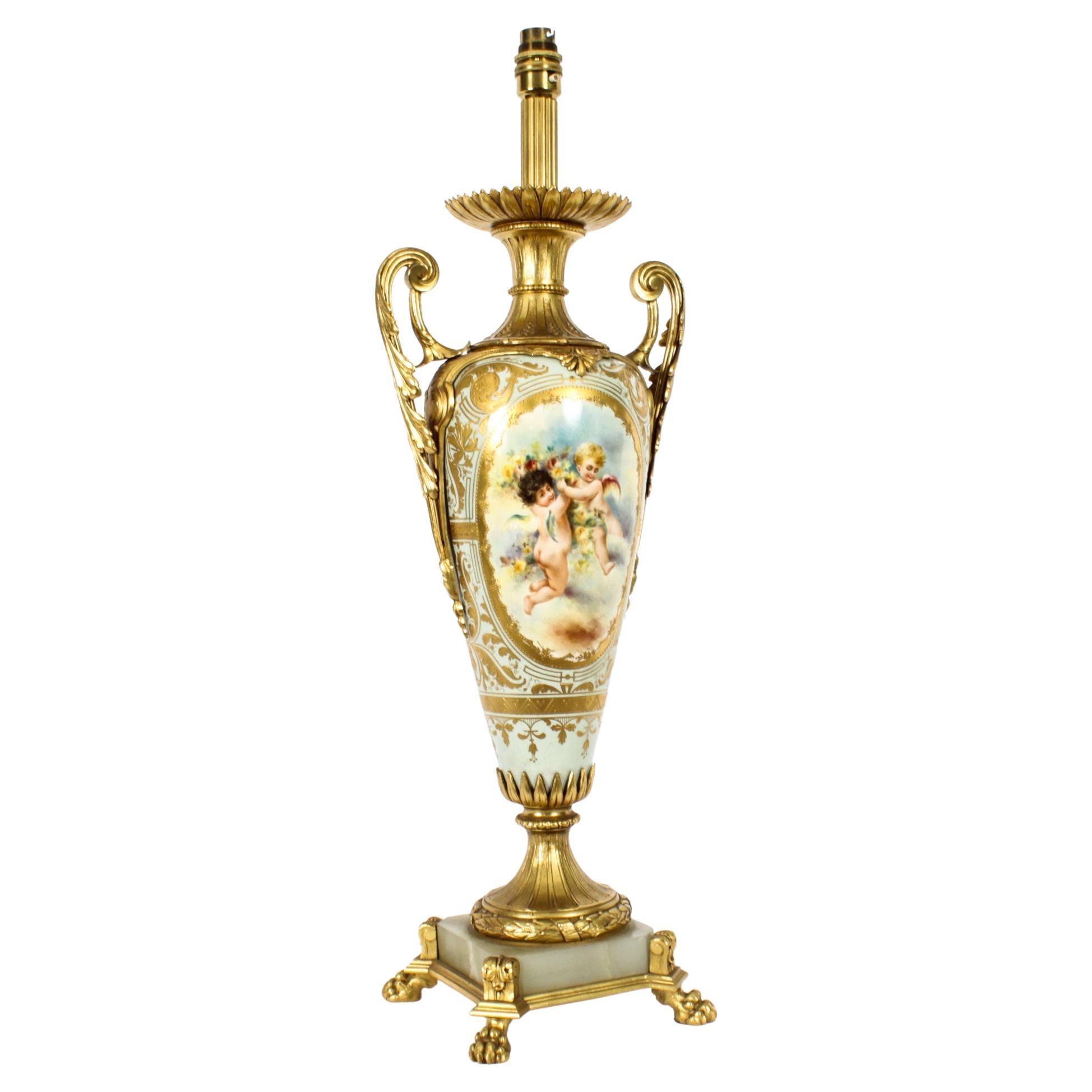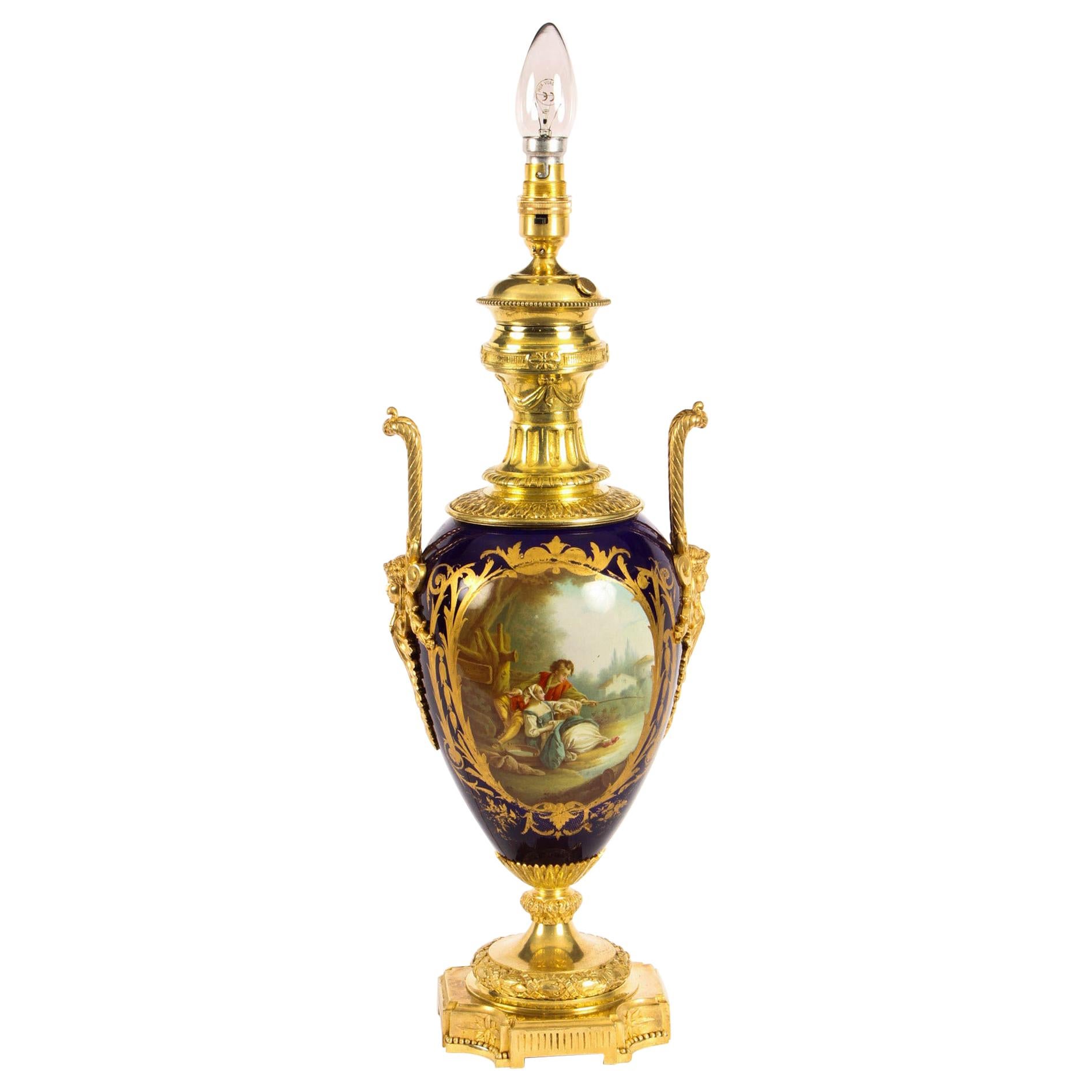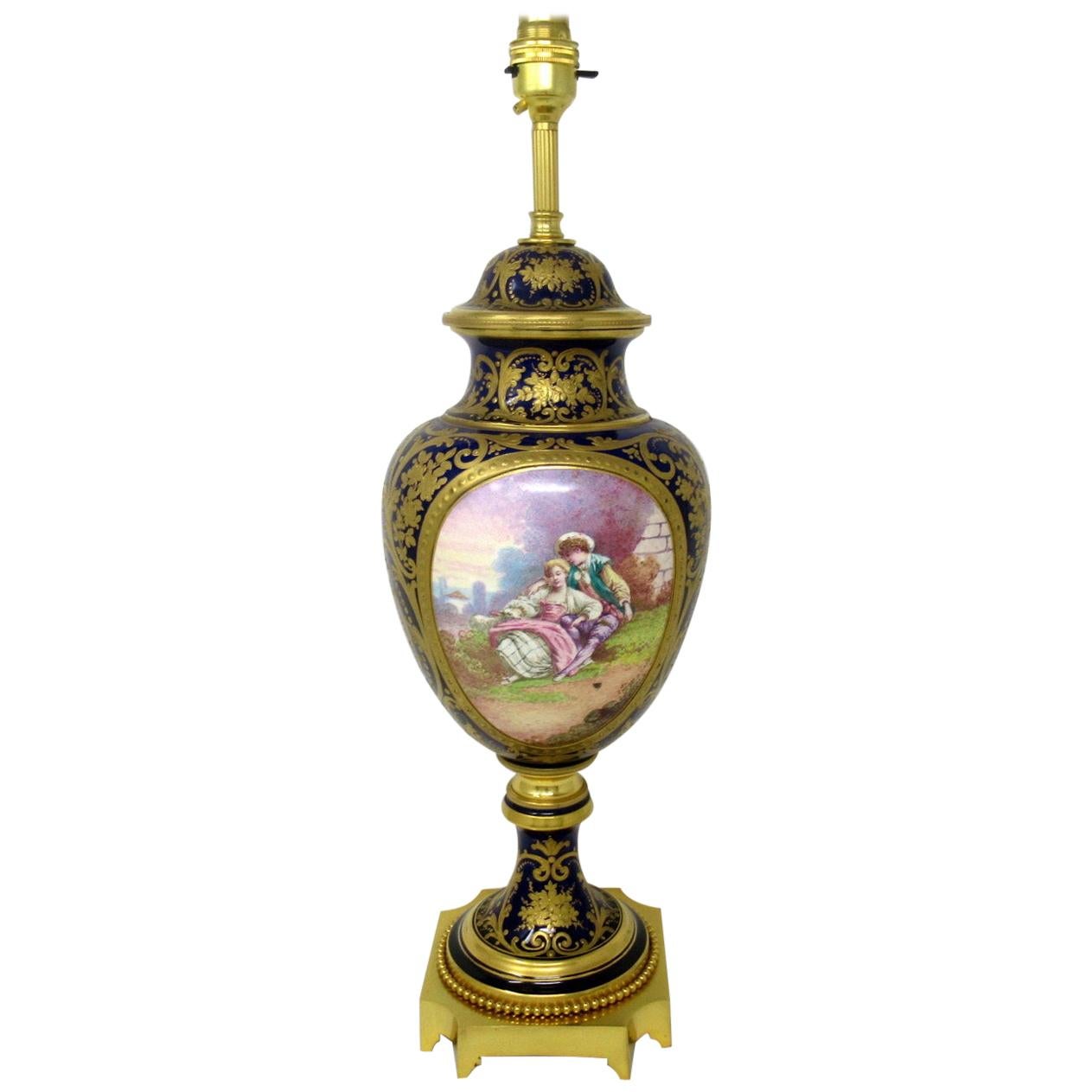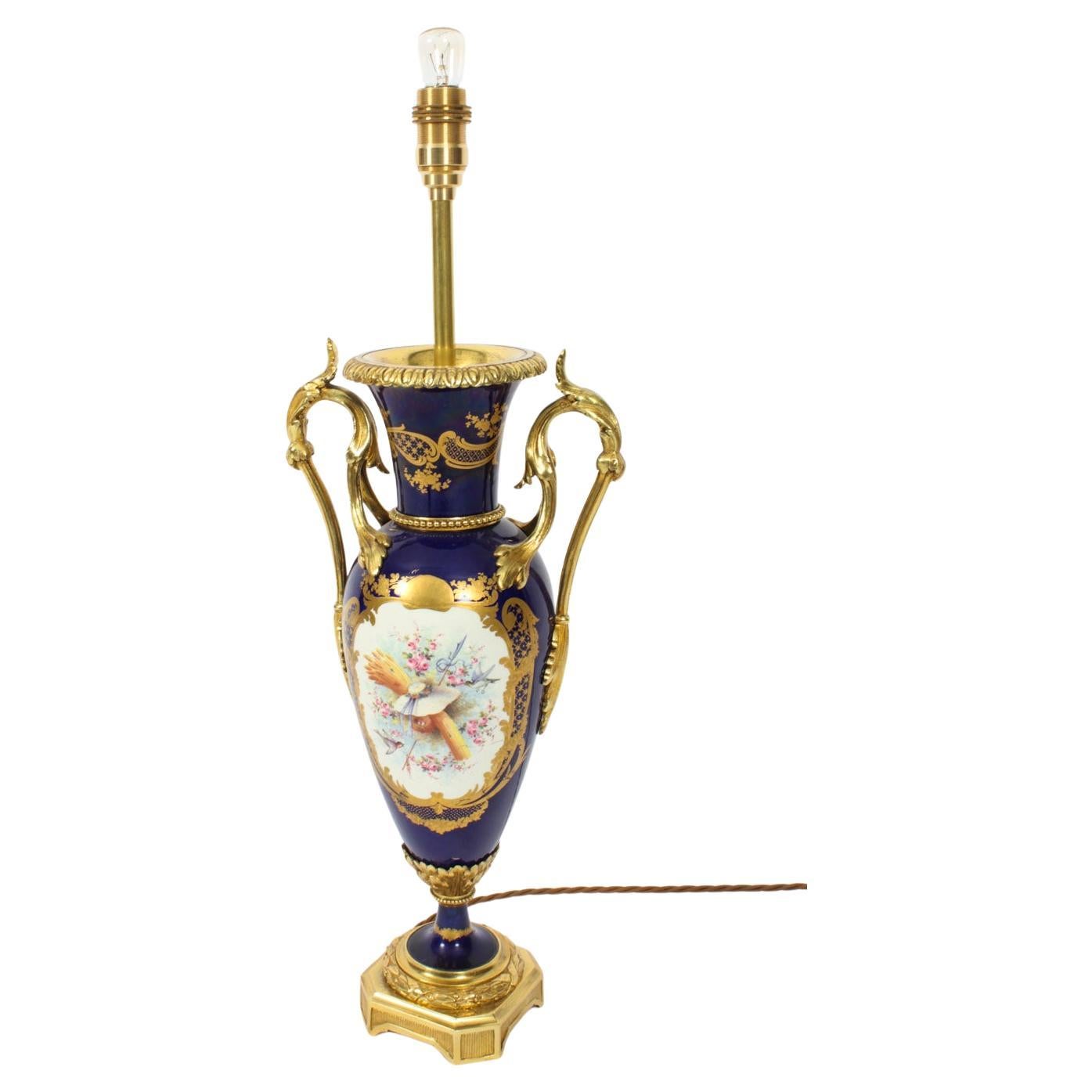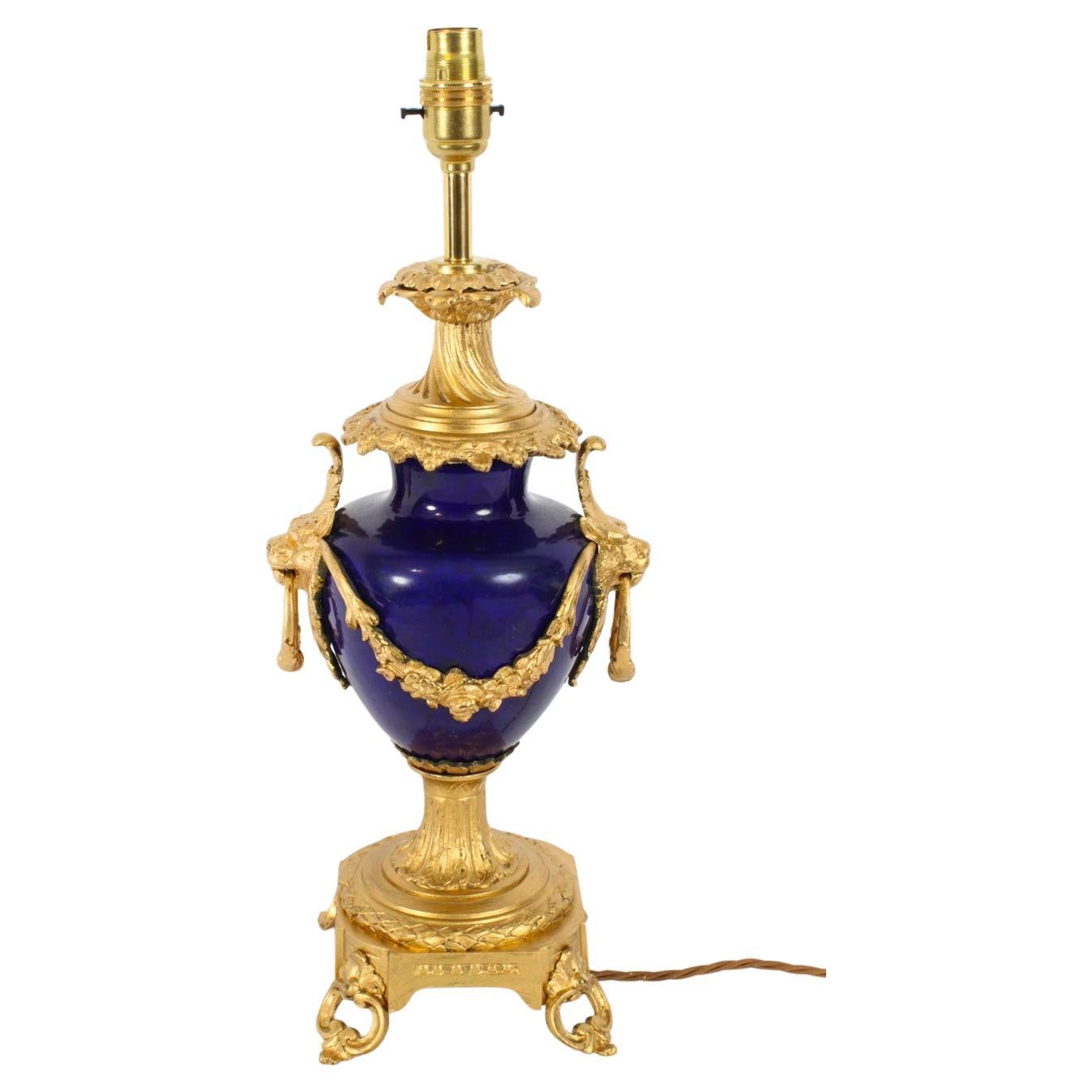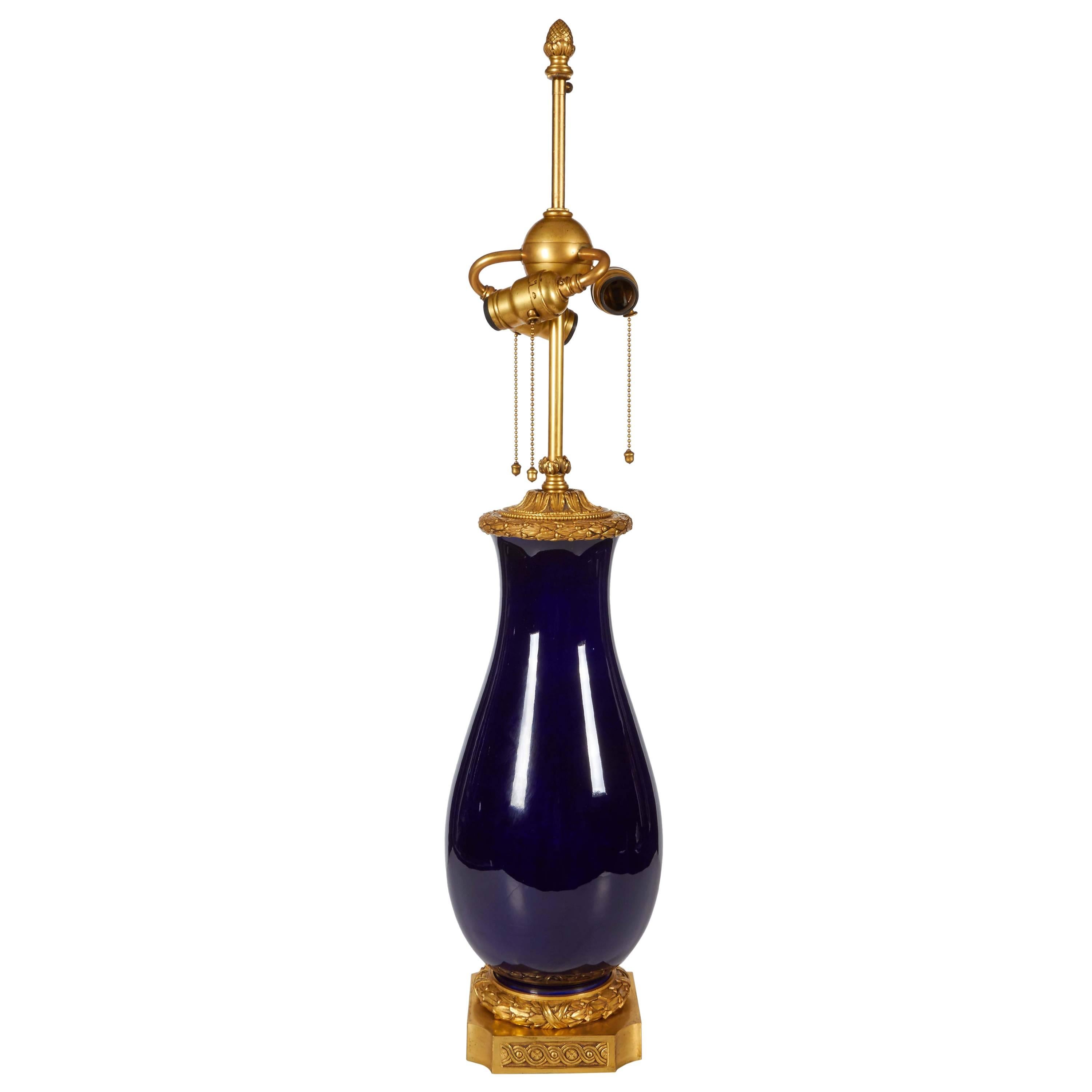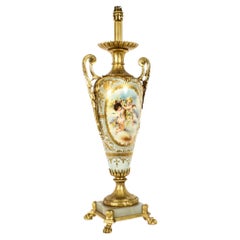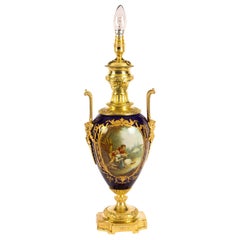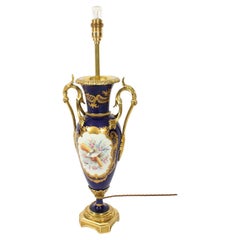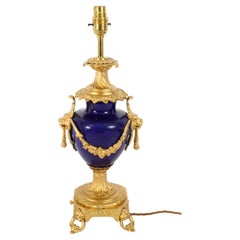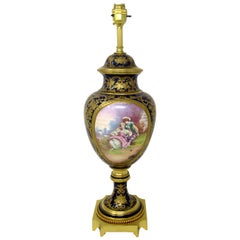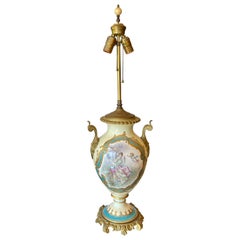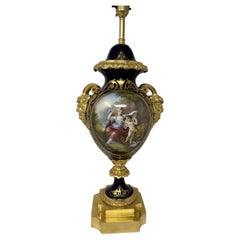Items Similar to Antique Bleu Royale Sèvres Porcelain Ormolu Table Lamp, 19th Century
Video Loading
Want more images or videos?
Request additional images or videos from the seller
1 of 15
Antique Bleu Royale Sèvres Porcelain Ormolu Table Lamp, 19th Century
$2,260.18
£1,650
€1,944.42
CA$3,105.61
A$3,475.76
CHF 1,814.08
MX$42,386.34
NOK 23,217.74
SEK 21,978.57
DKK 14,510.96
Shipping
Retrieving quote...The 1stDibs Promise:
Authenticity Guarantee,
Money-Back Guarantee,
24-Hour Cancellation
About the Item
This is a stunning large antique French Sèvres "Bleu Royale" hand painted porcelain and ormolu-mounted vase circa 1870 in date, later converted into a lamp.
The ovoid porcelain body is painted with gilt-framed panels depicting finely painted courting couple scenes on one side, a landscape on the other on a cobalt blue ground which is mounted on a circular laurel leaf cast ormolu base.
Add an elegant touch to any room in your home.
Condition:
In excellent condition with no chips, cracks or signs of repair, re-wired and pat tested please see photos for confirmation of condition.
Dimensions in cm:
Height 53 x width 16 x depth 12.5
Dimensions in inches:
Height 20.9 x width 6.3 x depth 4.9
Sevres Porcelain traces its roots in France to early craftsmen who had small manufacturing operations in such places as Lille, Rouen. St. Cloud, and most notably Chantilly. It is from Chantilly that a cadre of workers migrated to the Chateau de Vincennes near Paris to form a larger porcelain manufactory in 1738.
French King Louis XV, perhaps inspired by his rumoured relationship with Mistress Madame de Pompadour, took an intense interest in porcelain and moved the operation in 1756 to even larger quarters in the Paris suburb of Sèvres. Sèvres was also conveniently near the home of Madame de Pompadour and the King's own Palace at Versailles.
From the outset the king's clear aim was to produce Sèvres Porcelain that surpassed the established Saxony works of Meissen and Dresden. Though the French lacked an ample supply of kaolin, a required ingredient for hard-paste porcelain (pate dure), their soft-paste porcelain (pate tendre) was fired at a lower temperature and was thus compatible with a wider variety of colors and glazes that in many cases were also richer and more vivid. Unglazed white Sèvres Porcelain "biscuit" figurines were also a great success. However, soft-paste Sèvres Porcelain was more easily broken. Therefore, early pieces of Sèvres Porcelain that remain intact have become rare indeed.
The Sèvres Porcelain manufactory always seemed to be in dire financial straits despite the incredibly fine works it produced. In fact, the king's insistence that only the finest items be created may have contributed to the difficulties. Only a limited number of European nobility could afford the extravagant prices demanded for such works. King Louis XV and eventually his heir, the ill-fated Louis XVI, were obliged to invest heavily in the enterprise. Ultimately, the Sèvres Porcelain Factory produced items under the name of "Royal" and thus the well-known Sèvres mark was born. King Louis XV even mandated laws that severely restricted other porcelain production in France so as to retain a near monopoly for his Sèvres Porcelain. The king even willingly became chief salesman for the finest of his products, hosting an annual New Year's Day showing for French nobility in his private quarters at Versailles. He eagerly circulated among potential buyers, pitching the merits of ownership and policing the occasional light-fingered guest.
Sevres Porcelain may have indeed given the makers of Meissen and Dresden a run for their money by the end of the 18th century but for the French Revolution. By 1800, the Sèvres Porcelain Works were practically out of business due to the economic devastation of the new French Republic.
About the time when Napoleon Bonaparte named himself Emperor of France (1804), a new director was named for the Sèvres Porcelain Manufactory. Alexandre Brongniart, highly educated in many fields, resurrected Sèvres Porcelain. Soft-paste porcelain was eliminated altogether thanks to the earlier discovery of kaolin near Limoges. For four decades until his death, Brongniart presided over monumental progress for Sèvres Porcelain, catering not only to Napoleon himself, but at last to include the more financially profitable mid-priced market in the emerging middle class.
Ormolu (from French 'or moulu', signifying ground or pounded gold) is an 18th century English term for applying finely ground, high-carat gold in a mercury amalgam to an object of bronze. The mercury is driven off in a kiln leaving behind a gold-colored veneer known as 'gilt bronze'.
The manufacture of true ormolu employs a process known as mercury-gilding or fire-gilding, in which a solution of nitrate of mercury is applied to a piece of copper, brass, or bronze, followed by the application of an amalgam of gold and mercury. The item was then exposed to extreme heat until the mercury burned off and the gold remained, adhered to the metal object.
No true ormolu was produced in France after circa 1830 because legislation had outlawed the use of mercury. Therefore, other techniques were used instead but nothing surpasses the original mercury-firing ormolu method for sheer beauty and richness of color. Electroplating is the most common modern technique. Ormolu techniques are essentially the same as those used on silver, to produce silver-gilt (also known as vermeil).
- Dimensions:Height: 20.87 in (53 cm)Width: 6.3 in (16 cm)Depth: 4.93 in (12.5 cm)
- Materials and Techniques:
- Place of Origin:
- Period:
- Date of Manufacture:circa 1870
- Condition:
- Seller Location:London, GB
- Reference Number:Seller: A10051stDibs: LU950617678221
About the Seller
5.0
Platinum Seller
Premium sellers with a 4.7+ rating and 24-hour response times
Established in 1983
1stDibs seller since 2012
1,372 sales on 1stDibs
Typical response time: <1 hour
Associations
LAPADA - The Association of Arts & Antiques Dealers
- ShippingRetrieving quote...Shipping from: London, United Kingdom
- Return Policy
Authenticity Guarantee
In the unlikely event there’s an issue with an item’s authenticity, contact us within 1 year for a full refund. DetailsMoney-Back Guarantee
If your item is not as described, is damaged in transit, or does not arrive, contact us within 7 days for a full refund. Details24-Hour Cancellation
You have a 24-hour grace period in which to reconsider your purchase, with no questions asked.Vetted Professional Sellers
Our world-class sellers must adhere to strict standards for service and quality, maintaining the integrity of our listings.Price-Match Guarantee
If you find that a seller listed the same item for a lower price elsewhere, we’ll match it.Trusted Global Delivery
Our best-in-class carrier network provides specialized shipping options worldwide, including custom delivery.More From This Seller
View AllAntique Bleu Celeste Sevres Porcelain Ormolu Table Lamp 19th Century
Located in London, GB
This is a stunning large antique French Sevres hand-painted porcelain and ormolu mounted vase circa 1870 in date, later converted into a lamp.
The ovoid porcelain body is painted...
Category
Antique 1870s French Table Lamps
Materials
Onyx, Ormolu
Antique Cobalt Blue Sevres Porcelain Ormolu Table Lamp, 19th Century
Located in London, GB
This is a stunning large antique French Sevres cobalt blue hand painted porcelain and ormolu-mounted vase circa 1880 in date, later converted into a lamp.
The vase shaped porcelai...
Category
Antique 1880s French Porcelain
Materials
Ormolu
Antique Sevres Porcelain Blue & Gilt & Ormolu Table Lamp 19th Century
By Manufacture Nationale de Sèvres
Located in London, GB
This is a stunning antique French Sevres style Cobalt Blue hand-painted porcelain and ormolu mounted twin handled vase, circa 1880 in date, later converted into a lamp.
The large ...
Category
Antique 19th Century French Table Lamps
Materials
Ormolu
Antique Sevres Porcelain Royal Blue Ormolu Table Lamp 19th Century
Located in London, GB
This is a stunning large antique French Sevres style "Bleu Royale" porcelain and ormolu mounted vase circa 1870 in date, later converted into a lamp.
In Louis XVI style, of baluster form with wolf...
Category
Antique 19th Century French Louis XVI Table Lamps
Materials
Ormolu
19th Century French Hand-Painted and Gilt Porcelain Lamp
Located in London, GB
A beautiful French porcelain lamp with hand-painted scenes and delicate gilt decoration, dating from 1850.
The lamp features a pair of oval panels, one with a hand-painted classica...
Category
Antique 1850s French Porcelain
Materials
Porcelain
Antique French Samson Hand Painted & Gilt Porcelain Lamp, 19th Century
Located in London, GB
A beautiful large French Samson porcelain lamp with hand painted scenes and delicate gilt decoration, dating from C 1880.
The baluster shape...
Category
Antique 1880s French Table Lamps
Materials
Porcelain, Giltwood
You May Also Like
French Sèvres Porcelain Watteau Scene Ormolu Cobalt Blue Table Lamp 19th Century
By Manufacture Nationale de Sèvres
Located in Dublin, Ireland
Stunning French Sèvres soft paste signed porcelain and ormolu twin handle electric table lamp of traditional bulbous form and of outstanding quality, and good size proportions, raise...
Category
Antique 19th Century French Late Victorian Table Lamps
Materials
Ormolu
Antique Chinese Blue Ground Porcelain, Ormolu Mounted Lamp, E.F. Caldwell
By Edward F. Caldwell & Co.
Located in New York, NY
A very fine antique Chinese Royal blue ground porcelain and antique American Louis XVI style doré bronze-mounted table lamp by E.F. Caldwell, unsign...
Category
20th Century American Louis XVI Table Lamps
Materials
Ormolu
Antique French Porcelain & Gilt Bronze Serves Style Scenic Vase Table Lamp
Located in LOS ANGELES, CA
Antique French Porcelain & Gilt Bronze Serves Style Scenic Vase Table Lamp
Additional information:
Materials: bronze, porcelain
Color: bronze
Styled After: Manufacture de Sevre...
Category
Antique 19th Century Louis XVI Table Lamps
Materials
Bronze
French Sèvres Porcelain Watteau Scene Ormolu Cobalt Blue Table Lamp Bronze Satyr
By Manufacture Nationale de Sèvres
Located in Dublin, Ireland
Stunning French Sevres Soft Paste Signed Porcelain and Ormolu with Twin Handles modelled as a Satyre, Electric Table Lamp of traditional bulbous form and of outstanding quality, and ...
Category
Antique 19th Century French Late Victorian Table Lamps
Materials
Ormolu
French Sèvres Porcelain Still Life Flowers Ormolu Cobalt Blue Table Lamp Bronze
By Manufacture Nationale de Sèvres
Located in Dublin, Ireland
Stunning French Sevres Soft Paste Porcelain and Ormolu with Twin Handles modelled as Lions heads, Electric Table Lamp of traditional bulbous form and of outstanding quality, and good...
Category
Antique 19th Century French Late Victorian Table Lamps
Materials
Ormolu
1920s FBS Limoges Continental Blue Cobalt Porcelain & Gilt Vase Mounted as Lamp
Located in Germantown, MD
1920s FBS Limoges Continental Blue Cobalt Porcelain, hand painted and Gilt decorated Vase Mounted as Lamp.
Measures 6" in width, 5" in depth and stand 23" in height to the top of th...
Category
Early 20th Century French Louis XVI Table Lamps
Materials
Brass
More Ways To Browse
18th Century Sevres
18th Century Sevres Porcelain
Paris Porcelain Gold And White
English Blue And White Porcelain
Antique Soft Paste
Sevres Porcelain Napoleon
19th Century Sevre Pieces
Hard Paste Porcelain
Dresden Porcelain Marks
French Chateau Porcelain
Sevres Chateau
18th Century Figurines
Antique White Porcelain Figurines
Antique End Of Day Glass
Soft Paste Antique Porcelain
19th Century Dresden Porcelain
Sevres Side Table
Cobalt Side Table
